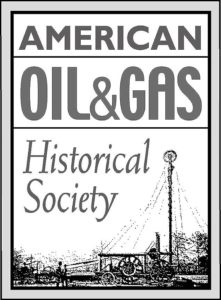by Bruce Wells | Jul 21, 2025 | This Week in Petroleum History
July 21, 1935 – “Diamond Glenn” McCarthy strikes Oil –
Glenn H. McCarthy struck oil 50 miles east of Houston in 1935, extending the already prolific Anahuac field. The well was the first of many for the Texas independent producer who would discover 11 Texas oilfields by 1945.
McCarthy became known as another “King of the Wildcatters” and “Diamond Glenn” by 1950, when his estimated worth reached $200 million ($2 billion today).
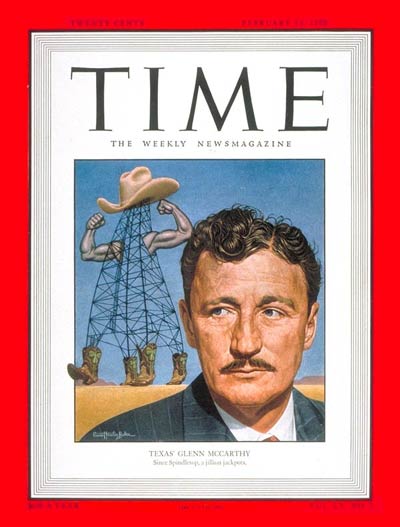
TIME magazine in 1950 featured Texas wildcatter Glenn McCarthy of Houston.
In addition to his McCarthy Oil and Gas Company, McCarthy eventually owned a gas company, a chemical company, a radio station, 14 newspapers, a magazine, two banks, and the Shell Building in Houston. In the late 1940s, he invested $21 million to build the 18-story, 1,100-room Shamrock Hotel — and reportedly spent $1 million on its St. Patrick’s Day 1949 opening gala, which newspapers dubbed “Houston’s biggest party.”
Learn more in “Diamond Glenn” McCarthy.
July 22, 1933 – Phillips Petroleum sponsors Flight around the World
Before 50,000 cheering New York City onlookers, former roughneck Wiley Post landed his Lockheed 5C Vega “Winnie Mae,” becoming the first person to fly solo around the world. Post had worked in oilfields near Walters, Oklahoma, when he took his first airplane ride with a barnstormer in 1919 and was inspired to take lessons.
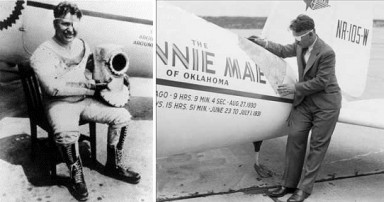
Thanks to a friendship with Frank Phillips, Wiley Post set altitude records and became the first person to fly solo around the world.
In 1926, on the first day of working at a well near Seminole, a metal splinter severely damaged his left eye, causing loss of sight. Post used the $1,700 in compensation to buy his first airplane. He became friends with Frank Phillips, president of Phillips Petroleum, sponsor of several high-altitude experimental flights. Phillips also sponsored the “Woolaroc” — winning plane of an August 1926 air race across the Pacific.

July 22, 1959 – Marker erected for Second U.S. Oil Well
The Pennsylvania Historical and Museum Commission dedicated a state marker to commemorate the man who drilled for oil just a few days after Edwin Drake completed the first U.S. commercial well on August 27, 1859. “After Drake’s discovery of oil in Titusville, some area residents attempted to sink their own well,” noted historians at Explore Pennsylvania. “The vast majority of such efforts failed.”
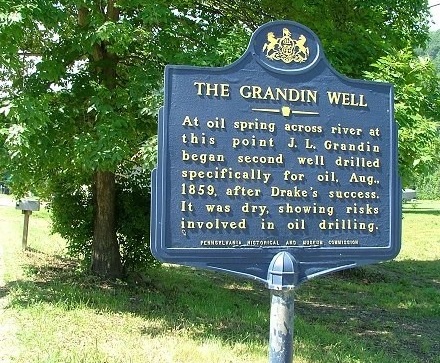
Pennsylvania historical marker for the 1859 Grandin well — America’s second oil well, which was a dry hole.
Using a simple spring pole, 22-year-old John Grandin and a local blacksmith began to “kick down” a well that would reach almost twice as deep as Drake’s cable-tool depth of 69.5 feet. Despite not finding the oil-producing formation (the Venango Sands), Grandin’s well produced several “firsts” for the young U.S. petroleum industry.
Learn more in First Dry Hole.
July 23, 1872 – “Real McCoy” Steam-Engine Lubricator
Using petroleum for improving the performance of locomotives became widespread when Elijah McCoy patented an automatic lubricator for steam engines. McCoy designed a device that applied oil through a drip cup to locomotive and ship steam engines. Instead of stopping engines to apply necessary lubrication, McCoy’s device provided it while they ran, saving railroads time and money.
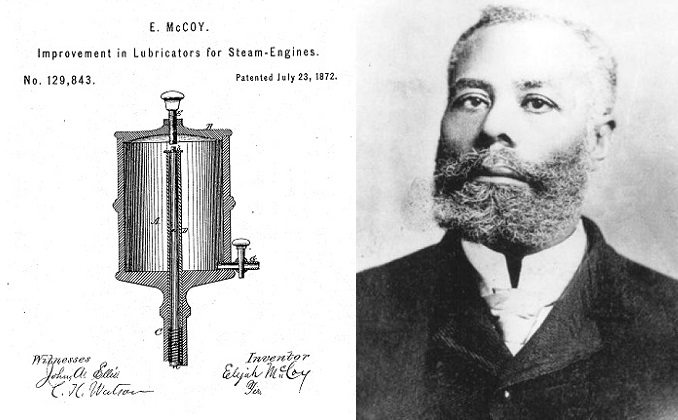
Elijah McCoy invented lubrication systems for steam engines, early beneficiaries of petroleum. Awarded more than 60 patents, he was inducted into the National Inventors Hall of Fame in 2001.
The Canadian-born McCoy was the son of slaves who had escaped Kentucky. After his family settled in Michigan, 15-year-old McCoy traveled to Scotland to study mechanical engineering. By the time he died in 1929, the inventor had received 60 patents, according to a 1994 Michigan historical marker.
The expression “the real McCoy” reportedly came from railroad engineers not wanting to buy low-quality copycats of his popular device. Before purchasing the lubricator, buyers would ask if it was “the real McCoy.”
July 23, 1951 – Desk & Derrick Clubs organize
After a secretary at Humble Oil and Refining Company organized the first club in New Orleans, the Association of Desk & Derrick Clubs (ADDC) of North America officially began with articles of association signed by the presidents of clubs in Jackson, Mississippi, New Orleans, Los Angeles, and Houston. By 1952, representatives from 40 clubs would attend the first ADDC convention, held at Houston’s Shamrock Hotel.
Learn more in Desk and Derrick Educators.

July 24, 2000 – BP unveils New Green and Yellow Logo
BP — the official name of a group of companies including Amoco, ARCO and Castrol — unveiled a new corporate identity brand, replacing the “Green Shield” logo with a green and yellow sunflower pattern.

The company also introduced a new corporate slogan: “Beyond Petroleum.” When BP — then British Petroleum — merged with Amoco in 1998, the company’s name briefly changed to BP Amoco before all stations converted to the BP brand.
July 25, 1543 – Oil reported in New World
The first documented report of oil in the New World resulted when a storm forced Spanish explorer Don Luis de Moscoso to land two of his brigantines at the mouth of the Sabine River. He had succeeded expedition leader Hernando de Soto and built seven of the small vessels to sail down the newly discovered Mississippi River and westward along the Gulf Coast.
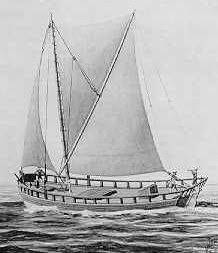
Spanish explorers used brigantines to sail along the Gulf Coast in 1543.
According to an account of the expedition, Indians knew of the future Texas’ natural seeps. “There was found a skumme, which they call Copee, which the Sea casteth up, and it is like Pitch, wherewith in some places, where Pitch is wanting, they pitch their ships; there they pitched their Brigandines.”
Learn more about the first reports of oil worldwide in Earliest Signs of Oil.
July 27, 1918 – Standard Oil of New York launches Concrete Tanker
America’s first concrete vessel designed to carry oil, the Socony, left its shipyard at Flushing Bay, New York. Built for the Standard Oil Company of New York, the barge was 98 feet long with a 32-foot beam and carried oil in six center and two wing compartments, “oil-proofed by a special process,” according to the journal Cement and Engineering News.
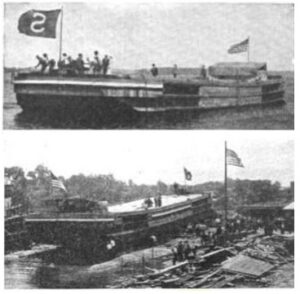
Socony, the first concrete oil tanker, launched in 1918. Below is a second version of the oil barge.
“Eight-inch cast iron pipe lines lead to each compartment and the oil pump is located on a concrete pump room aft,” the journal explained. Steel shortages during World War II would lead to the construction of larger reinforced concrete oil tankers.
_______________________
Recommended Reading: The Big Rich: The Rise and Fall of the Greatest Texas Oil Fortunes (2009); From Oklahoma to Eternity: The Life of Wiley Post and the Winnie Mae
(2009); From Oklahoma to Eternity: The Life of Wiley Post and the Winnie Mae (1998); Myth, Legend, Reality: Edwin Laurentine Drake and the Early Oil Industry
(1998); Myth, Legend, Reality: Edwin Laurentine Drake and the Early Oil Industry (2009); Western Pennsylvania’s Oil Heritage
(2009); Western Pennsylvania’s Oil Heritage (2008); Trek of the Oil Finders: A History of Exploration for Petroleum (1975); Anomalies, Pioneering Women in Petroleum Geology, 1917-2017; Breaking the Gas Ceiling: Women in the Offshore Oil and Gas Industry (2019). Your Amazon purchase benefits the American Oil & Gas Historical Society. As an Amazon Associate, AOGHS earns a commission from qualifying purchases.
(2008); Trek of the Oil Finders: A History of Exploration for Petroleum (1975); Anomalies, Pioneering Women in Petroleum Geology, 1917-2017; Breaking the Gas Ceiling: Women in the Offshore Oil and Gas Industry (2019). Your Amazon purchase benefits the American Oil & Gas Historical Society. As an Amazon Associate, AOGHS earns a commission from qualifying purchases.
_______________________
The American Oil & Gas Historical Society (AOGHS) preserves U.S. petroleum history. Please become an AOGHS annual supporter and help maintain this energy education website and expand historical research. For more information, contact bawells@aoghs.org. © 2025 Bruce A. Wells. All rights reserved.
by Bruce Wells | Jul 16, 2025 | Petroleum Pioneers
The Texas independent producer who “rocketed into the national imagination in the late 1940s.”
As giant oilfield discoveries created Texas millionaires after World War II, people started calling “Diamond Glenn” McCarthy the reigning King of the Wildcatters. Some historians have said a $21 million hotel McCarthy opened in 1949 put Houston on the map.
Glenn H. McCarthy’s petroleum career began with a 1935 well 50 miles east of Houston when he and partner R.A. Mason completed their No. 1 White well with production of almost 600 barrels of oil a day. The well extended by three miles to the north the already productive Anahuac field — which McCarthy had earlier discovered.
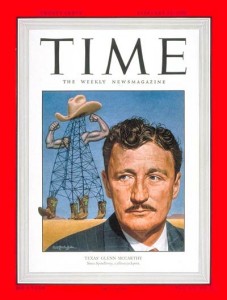
After discovering 11 Texas oil fields, Glenn McCarthy appeared on the February 13, 1950, cover of TIME.
By 1945, McCarthy had gone on to discover 11 new oilfields and extend others. In Brazoria County one year later, he drilled the highest-pressure gas well drilled to that time. Described as a “bombastic, plucky Irishman best known for building the famous Shamrock Hotel,” the Texas independent oilman would be featured on the February 13, 1950, cover of TIME. (more…)
by Bruce Wells | Mar 17, 2025 | This Week in Petroleum History
March 17, 1890 – Sun Oil Company founded –
Established in 1886 by Joseph Pew and Edward Emerson to provide light and heat to Pittsburgh, the Peoples Natural Gas Company expanded into production, becoming the Sun Oil Company of Ohio. The new company acquired leases near Findlay and began “producing petroleum, rock and carbon oil, transporting and storing same, refining, purifying, manufacturing such oil and its various products.”
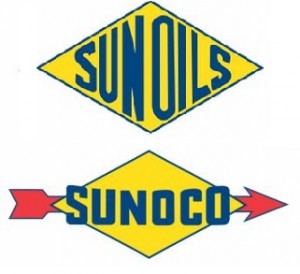
Sun Oil Company marketed its Sun Oils brand from 1894 to 1920 and its original Sunoco brand from 1920 to 1954.
Sun Oil Company went public in 1925 with its stock appearing for the first time on the New York Stock Exchange. Four years later, a partnership with downhole gyroscope inventor Elmer Sperry created Sperry-Sun Drilling Services.
March 17, 1923 – Discovery leads to Seminole Oil Boom
The Betsy Foster No. 1 well, a 2,800-barrel-a-day oil gusher near Wewoka, county seat of Seminole County, Oklahoma, launched the Seminole area boom. The discovery south of Oklahoma City was followed by others in Cromwell and Bethel (1924), and Earlsboro and Seminole (1926). Thirty-nine separate oilfields would be found in Seminole and Pottawatomie, Okfuskee, Hughes, and Pontotoc counties. Once among the poorest regions in Oklahoma, by 1935 the greater Seminole area became the largest supplier of oil in the world.
Learn more in Seminole Oil Boom.
March 17, 1949 – First Commercial Application of Hydraulic Fracturing
A team from Halliburton and Stanolind companies converged on an oil well about 12 miles east of Duncan, Oklahoma, and performed the first commercial application of hydraulic fracturing.
A 1947 experimental well had fractured a natural gas field in Hugoton, Kansas, and proven the possibility of increased productivity. The technique was developed and patented by Stanolind (later known as Pan American Oil Company) and an exclusive license was issued to Halliburton Company to perform the process. Four years later, the license was extended to all qualified oilfield service companies.
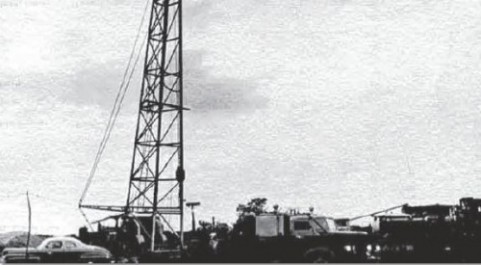
The first commercial hydraulic fracturing job (above) took place in 1949 about 12 miles east of Duncan, Oklahoma. Photo courtesy Halliburton.
“Since that fateful day in 1949, hydraulic fracturing has done more to increase recoverable reserves than any other technique,” proclaimed a Halliburton company spokesman in 2009, adding that more than two million fracturing treatments have been pumped without polluting an aquifer.
Erle P. Halliburton patented an efficient well-cementing technology in 1921 that improved oil production while protecting the environment. The earliest attempts to increase petroleum production by fracturing geologic formations began in the 1860s.
Learn more in Shooters – A ‘Fracking’ History.

March 17, 1949 – “Diamond Glenn” opens Shamrock Hotel
Texas independent producer “Diamond Glenn” McCarthy hosted the grand opening of his $21 million, 18-story, 1,100-room Shamrock Hotel on the outskirts of Houston. McCarthy reportedly spent another $1 million for the hotel’s St. Patrick’s Day opening day gala, including arranging for a 16-car Santa Fe Super Chief train to bring friends from Hollywood.
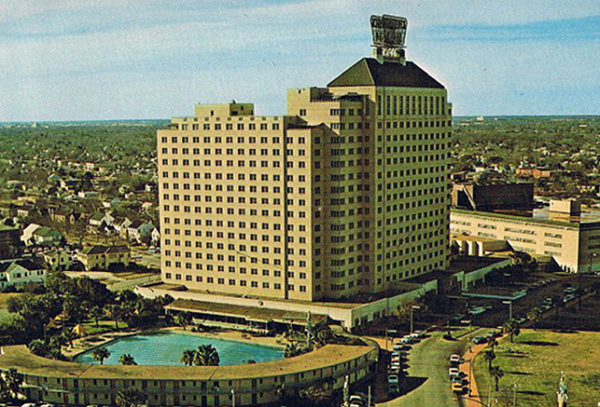
After paying $21 million to construct the Shamrock Hotel, Glenn McCarthy spent another $1 million for its grand opening on St. Patrick’s Day 1949. The 1,100-room Houston hotel was demolished in 1987.
The Texas wildcatter, who had discovered 11 oilfields by 1945, also introduced his own label of bourbon at Shamrock, the largest hotel in the United States at the time. Dubbed Houston’s biggest party, the Shamrock’s debut “made the city of Houston a star overnight,” one newspaper reported.
Learn more in “Diamond Glenn” McCarthy.
March 18, 1937 – New London School Explosion Tragedy
With just minutes left in the school day, a natural gas explosion destroyed the New London High School in Rusk County, Texas. Odorless gas (a residual natural gas called casing-head gas) had leaked into the basement and ignited with an explosion heard four miles away. East Texas oilfield workers — many with children attending the school — rushed to the scene, as did a cub reporter from Dallas, Walter Cronkite.
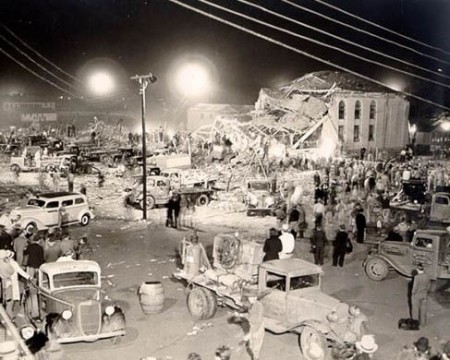
Roughnecks from the East Texas oilfield rushed to the devastated school and searched for survivors throughout the night. Photo courtesy New London Museum.
Despite desperate rescue efforts, 298 people were killed that day (dozens more later died of injuries). The explosion’s source was later found to be an electric wood-shop sander that sparked odorless gas that had pooled beneath and in the walls of the school. As a result of this disaster, Texas and other states passed laws requiring that natural gas be mixed with a malodorant to give early warning of a gas leak.
Learn more about the tragedy in New London School Explosion.
March 18, 1938 — First Offshore Well drilled off Louisiana
Oil production from a well drilled by Pure Oil and Superior Oil companies helped launch the modern offshore industry. The Creole oilfield in Louisiana’s offshore Cameron Parish was the first discovered in the open waters of the Gulf of Mexico, according to the Louisiana Department of Natural Resources (DNR). “A look back at both the Creole platform and others that followed after World War II provides a glimpse of history in the making,” noted Offshore magazine in 2014.
More offshore wells followed, including the Kerr-McGee drilling platform, Kermac Rig No. 16, which in 1947 became the first offshore rig out of sight of land. By the end of 1949, offshore exploration had discovered 11 oil and natural gas fields.
Learn more in Offshore Oil History.

March 20, 1919 – American Petroleum Institute founded
Tracing its roots to World War I when the petroleum industry and Congress worked together to fuel the war effort, the American Petroleum Institute (API) was founded in New York City. Within two years, the organization had improved an 1876 French scale to measure petroleum density relative to water — a standard later adopted and called API gravity. Based in Washington, D.C. since 1969, API has lobbied on behalf of major oil and natural gas companies while maintaining standards and recommended industry practices.
March 20, 1973 – Pennsylvania Boom Town recognized as Historic
The once-famous oil boom town of Pithole, Pennsylvania, was listed in the National Register of Historic Places. An 1865 oilfield discovery at Pithole Creek launched a drilling boom for the early U.S. petroleum industry, which had begun six years earlier in nearby Titusville. The Pithole field’s production would lead to construction of the nation’s first oil pipeline, but the boom ended after about 500 days.
Learn more in Oil Boom at Pithole Creek.
March 21, 1881 – Earth Scientist becomes USGS Director
President James Garfield appointed John Wesley Powell director of the United States Geological Survey (USGS), a scientific agency established two years earlier. Powell, who led USGS for the next decade, laid the foundation for modern earth science research.
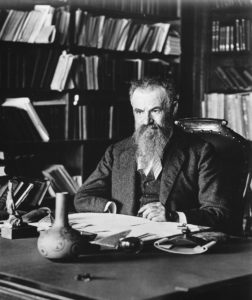
John Wesley Powell at his desk in Washington, D.C., in 1896. Photo courtesy Smithsonian Institution.
Born in 1834 at Mount Morris, New York, Powell was a Union officer during the Civil War, where he lost an arm at the Battle of Shiloh. After the war, he became a respected geologist and expedition leader, organized early surveys in the West, and helped establish USGS in 1879.
Powell advocated the national mapping standards and geodetic system still in use today. In 1884, Powell testified to Congress, “A Government cannot do any scientific work of more value to the people at large than by causing the construction of proper topographic maps of the country.”

March 23, 1858 – First U.S. Oil Exploration Company reorganizes
Investors from New Haven, Connecticut, organized the Seneca Oil Company with $300,000 in capital after purchasing the Titusville leases of the Pennsylvania Rock Oil Company, which had been founded in 1854 by George Bissell.
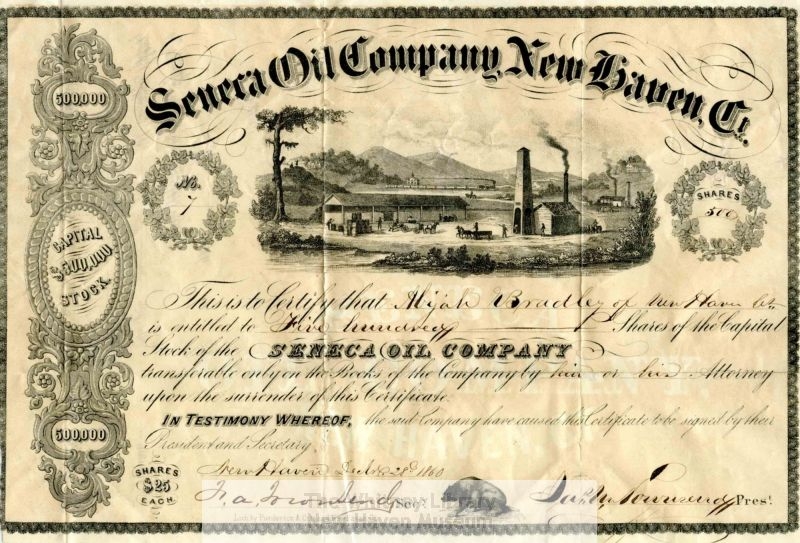
Seneca Oil drilled the first U.S. well. Image courtesy New Haven Museum.
Bissell, who had investigated oil seeps south of Titusville, originated the idea of producing and refining oil to make kerosene lamp fuel. The New Haven investors nevertheless excluded him from the oil exploration company.
Learn more in George Bissell’s Oil Seeps.
_______________________
Recommended Reading: Trek of the Oil Finders: A History of Exploration for Petroleum (1975); A History of the Greater Seminole Oil Field (1981); The Frackers: The Outrageous Inside Story of the New Billionaire Wildcatters
(1981); The Frackers: The Outrageous Inside Story of the New Billionaire Wildcatters  (2014).; The Green and the Black: The Complete Story of the Shale Revolution, the Fight over Fracking, and the Future of Energy
(2014).; The Green and the Black: The Complete Story of the Shale Revolution, the Fight over Fracking, and the Future of Energy (2016); Corduroy Road: The story of Glenn H. McCarthy (1951); A Texas Tragedy: The New London School Explosion
(2016); Corduroy Road: The story of Glenn H. McCarthy (1951); A Texas Tragedy: The New London School Explosion (2012); Offshore Pioneers: Brown & Root and the History of Offshore Oil and Gas
(2012); Offshore Pioneers: Brown & Root and the History of Offshore Oil and Gas (2011); Cherry Run Valley: Plumer, Pithole, and Oil City, Pennsylvania, Images of America
(2011); Cherry Run Valley: Plumer, Pithole, and Oil City, Pennsylvania, Images of America (2000); The Powell Expedition: New Discoveries about John Wesley Powell’s 1869 River Journey
(2000); The Powell Expedition: New Discoveries about John Wesley Powell’s 1869 River Journey (2017); Myth, Legend, Reality: Edwin Laurentine Drake and the Early Oil Industry
(2017); Myth, Legend, Reality: Edwin Laurentine Drake and the Early Oil Industry (2009). Your Amazon purchase benefits the American Oil & Gas Historical Society. As an Amazon Associate, AOGHS earns a commission from qualifying purchases.
(2009). Your Amazon purchase benefits the American Oil & Gas Historical Society. As an Amazon Associate, AOGHS earns a commission from qualifying purchases.
_______________________
The American Oil & Gas Historical Society (AOGHS) preserves U.S. petroleum history. Please become an AOGHS supporter and help maintain this energy education website and expand historical research. For more information, contact bawells@aoghs.org. Copyright © 2025 Bruce A. Wells. All rights reserved.




(2009); From Oklahoma to Eternity: The Life of Wiley Post and the Winnie Mae
(1998); Myth, Legend, Reality: Edwin Laurentine Drake and the Early Oil Industry
(2009); Western Pennsylvania’s Oil Heritage
(2008); Trek of the Oil Finders: A History of Exploration for Petroleum (1975); Anomalies, Pioneering Women in Petroleum Geology, 1917-2017; Breaking the Gas Ceiling: Women in the Offshore Oil and Gas Industry (2019). Your Amazon purchase benefits the American Oil & Gas Historical Society. As an Amazon Associate, AOGHS earns a commission from qualifying purchases.














